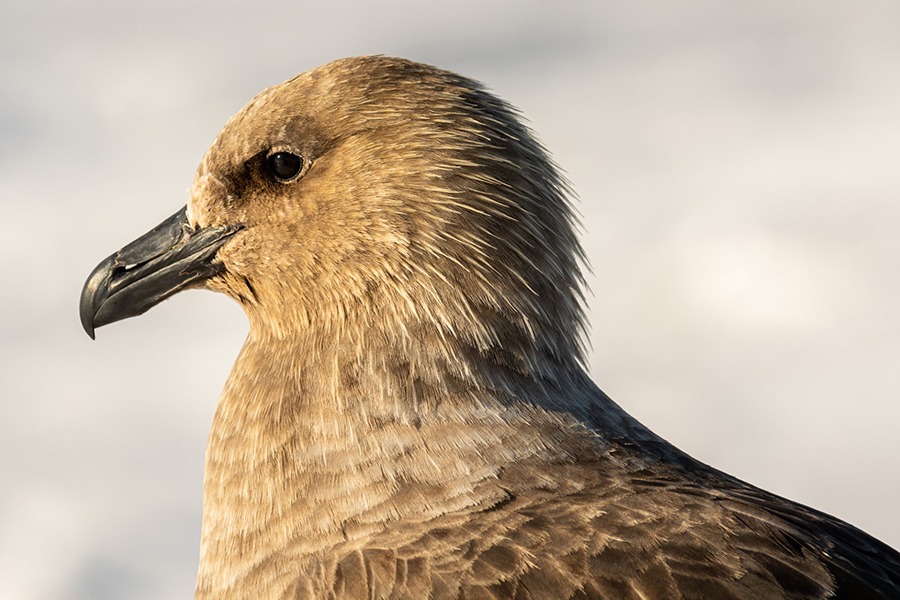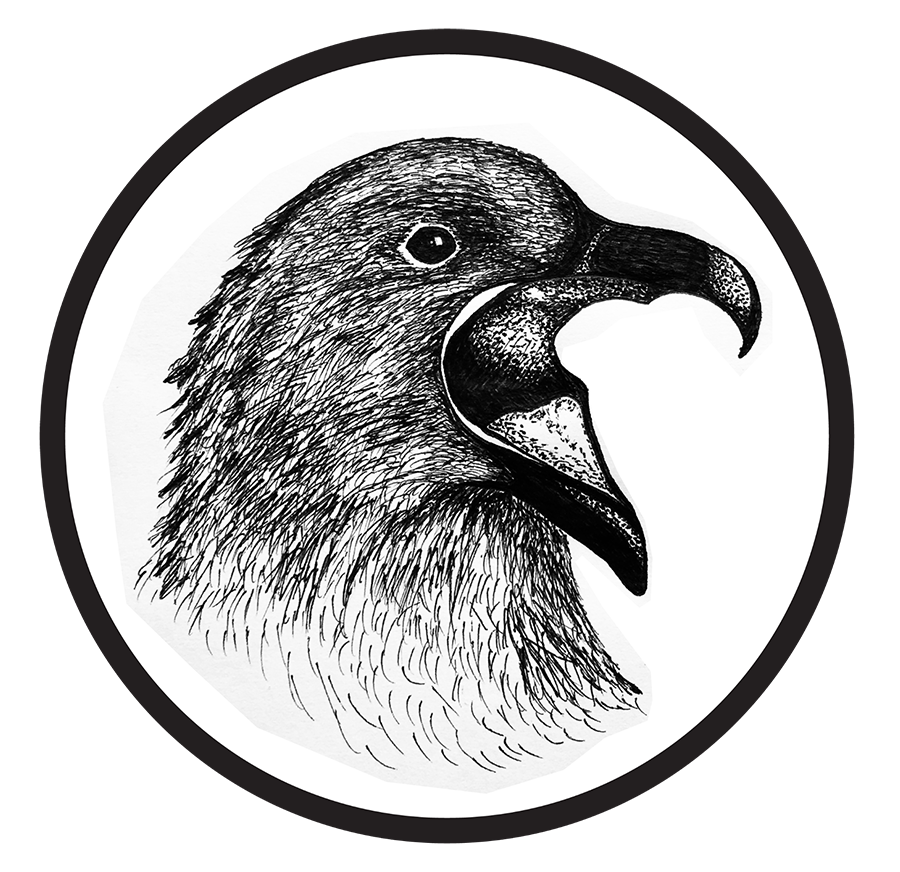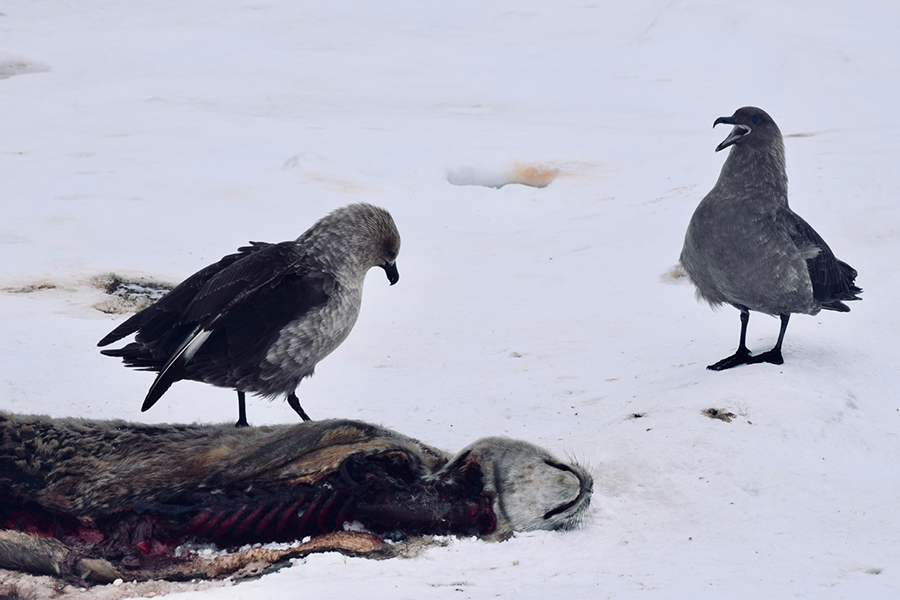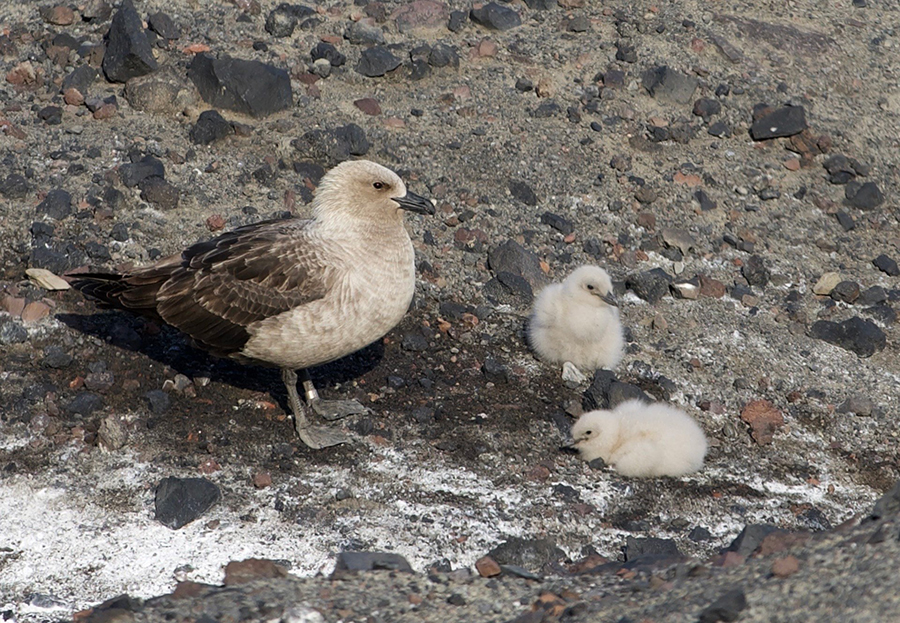
Photo Credit: Mike Lucibella |
The profile of a south polar skua, one of the most infamous seasonal residents around Antarctica. |
The Infamy of the Skua
By Rachel Heckerman, Antarctic Sun Guest Writer
Posted November 16, 2020
An Appreciation of Antarctica's Most Infamous Avian Inhabitant
Like clockwork in late November, the residents of McMurdo Station look to the sky and spot something that many haven’t seen in months—birds.

Photo Credit: Mike Lucibella
With Mount Erebus in the background, a south polar skua surveys McMurdo Station from atop Observation Hill.
The arrival of these feathered creatures is greeted by many with curiosity and anticipation, but also with some suspicion. The audacious Stercorariidae maccormicki, or south polar skua, has an infamous reputation that precedes it.
“Before I came down to McMurdo, I was told to be extra careful transporting food outside,” said Daniel Keady, a hazardous waste worker. “I was warned that even though they may look like it, skuas aren’t actually birds. They’re actually tiny pirates with feathers and wings.”
The tenacious south polar skua is known for aggressively snatching anything it thinks might be food and seemingly has little fear of dive-bombing McMurdo residents from the sky to get at it.
“As a person who already has a slight fear of birds, the skua really brought this affliction out of me,” Laura Lanigan, a dining attendant. “They would linger in proximity overhead and stand in the way of the hiking path like a stone. I would tense up to make myself small and promptly remove myself from the area. To respect the Antarctic Treaty is to realize the skua owns the territory.”
Pirates, bullies, and kleptoparasites are just some of the nicknames that skuas have acquired over the years. In their natural habitat, they are known to steal both the eggs and young chicks from Adelie penguins, but will scavenge nearly anything else for survival. They have a persona that mirrors the Antarctic terrain: both fierce and extreme.
Skuas Over History

Photo Credit: Julie Webber
Skuas are a popular inspiration for stories and artwork amongst residents of McMurdo Station, such as this sticker designed by Julie Webber.
South polar skuas have been making bold impressions on Antarctic explorers throughout history. During the famous race to the South Pole between 1909 and 1912, the two expedition leaders, Robert Falcon Scott of England and Roald Amundsen of Norway, both encountered the birds on their polar journey.
Amundsen, while returning from the Pole pulling with him a recently deceased and slain husky, recorded that:
“To our unspeakable astonishment two great birds—skua gulls—suddenly came flying straight towards us. They brought us a message from the living world into this realm of death. … They did not allow themselves a long rest, these messengers from another world. They then rose aloft and flew on to the south. Mysterious creatures! They were now exactly half-way between Framheim and the Pole, and yet they were going farther inland. Were they going over to the other side?”
They believed that the husky’s blood initially attracted the skuas from over 180 miles from the coast.
Scott’s team was just over 200 miles away from the South Pole when his team encountered a skua.
“A skua gull visited us on the march this afternoon – it was evidently curious, kept alighting on the snow ahead, and fluttering a few yards as we approached. It seemed to have had little food – an extraordinary visitor considering our distance from the sea.”
Even today, skuas continually surprise those who work on the Ice. Ash Fusiarski, a field assistant for the British Antarctic Survey, had firsthand experience dealing with daring skua behavior.
“We once had skuas blocking our path on the flight runway at our station. We decided that if we played skua distress calls, that maybe it would scare the skuas away,” Fusiarski said.
His team was trying to prevent a bird strike, a collision between an airplane and an airborne animal, bad for the plane as well as the bird. But when they played the distress calls, something unexpected happened.
“More skuas actually came flying to the scene. It was a nightmare. It was as if the distress of a fellow skua was an opportunity for them,” Fusiarski said.
Finding Food

Photo Credit: Daniel Keady
Two hungry skuas pick at the remains of a deceased seal pup. Skuas are resourceful, and will scavenge nearly anything to eat.
For a bird to survive at the bottom of the world, it has to be self-reliant and resourceful, but at first glance, the appearance of the south polar skua doesn’t seem all that impressive. It’s easy to mistake it for a dark-colored common seagull, but the south polar skua is much larger—approximately three times the weight of a common gull and several inches longer beak to tail. With a high density of feathers, and an opportunistic attitude, skuas are equipped to make the great voyage south every year and survive the hardships of the icy continent. With food in short supply there, skuas often rely on some grisly techniques to get the nutrition they need to survive.
In the austral spring, when skuas arrive on the continent, they are hungry and in search of Antarctica’s most famous animal—penguins. However, they rarely search out fully grown adults, but rather their more vulnerable eggs and chicks. These birds of prey won’t show interest in the penguins until they start laying eggs around the start of November.
Skuas are clever in their predation tactics, and seem to show no remorse in their execution. Able to lift more than they weigh, a skua can easily fly away with a hunted chick or scavenged egg. Masters of theft, they have been known to distract adult penguins into leaving their eggs—waiting to swoop in when no one is looking.
George Murray Levick, a zoologist on Robert Falcon Scott’s ill-fated polar expedition, was a witness to what happens when a skua hunts down a penguin chick.
“Should a chick wander away from the protecting old birds, a Skua is almost certain to pounce upon and kill it. This it does by pecking its eyes out…and quickly devours the kidneys,” Levick wrote.
Skuas know better than to go after a healthy, full-grown Adelie penguin. Although they are dimensionally the same size, penguin bodies are made up of blubber, and weigh about three times the weight of a skua. In addition, penguins have solid bones which are harder and more resilient than the skua’s hollow bones. Should an Adelie penguin go toe to toe with a skua, it would likely not end well for the skua.

Photo Credit: Mike Lucibella
An Adelie penguin defends its nest from a skua at the Cape Crozier penguin colony.
However, penguins aren’t the skua’s only source of food. They will gladly snatch meals away from other species of birds, such as gulls and terns. Skuas are kleptoparasites, a form of predation where an animal steals food from others. This allows skuas to outsource the work of finding food to other species if nothing is immediately available to them. Skuas wait for an opportune moment to approach other birds—usually right after they’ve eaten—then intimidate and stress the engorged birds so they regurgitate their food for the skua to feed off of.
Many skuas hang around seal pupping colonies at the beginning of the austral summer, helping themselves to the afterbirth or dead carcass of Weddell seals. If nothing else is available, fish and krill are also acceptable for the skua, as well as mosses and kelps. There is hardly anything that they won’t eat.
Living, Breeding, Surviving
The skua is one of the southernmost breeding birds in the world, and life isn’t easy for them. From the time it is born, skuas have to learn to fight for their survival against the elements, as well as from their own kin. A study conducted in 1998 in Victoria Land by the University of Siena in Italy determined that of the 101 breeding pairs monitored, 77 percent of the eggs successfully hatched, but only about 20 percent reached fledging age.
A female skua will typically lay two eggs. Most likely, one will be rejected and cannibalized by the female before it hatches. Should both chicks hatch, one chick will usually show its dominance and kill the other within the first week of life. It is rare to see both offspring make it to fledging age.

Photo Credit: Rachel Heckerman
A skua parent looks over its two chicks. It’s unusual for two chick to hatch, and even rarer for both of them to survive to fledging age.
Skuas don’t build an actual nest for their offspring—they lay their eggs in specific sites, usually on top of a patch of moss or exposed rock. Most skua nesting sites lie within or near penguin rookeries, and their eggs are vulnerable to being trampled by penguins on their way to the sea. The exposure of the nests also leaves the eggs and chicks more exposed to the intense Antarctic winds that could blow them away. The only real protection from the elements chicks receive is the warmth of laying underneath their mother until they are able to fly at around 50 days.
With all these factors resulting in such a low breeding success rate, it might seem difficult to see why skuas prefer to breed in Antarctica in the first place.
“In general, polar waters are very productive and nutrient-rich. Birds that make the effort to migrate to polar-regions during the summer have access to abundant resources, having little competition once they get there,” said Robyn Thomas, a seabird specialist and educator for the Seattle Audubon Society. “Additionally, there are no land predators of skua chicks, which is a major advantage for seabirds, even if that means chicks have to withstand a harsher climate.”
A demographic study done by ecologist David Ainley between 1961 and 1983 revealed that a skua’s quest to reproduce with a partner usually begins when they are at age five, but only about half the population have been successful by the time they reach eight years of age. Once they select a mate, they are loyal to their partners and return to the same nesting site to mate year after year, even if they aren’t always successful. Over their typical 40-year lifespan, it is quite possible that a pair will only raise about five chicks. Because of their isolation away from human most activities, skua populations have remained steady over the years, with approximately 1,300 pairs returning to Antarctica every austral summer.
After Antarctica
Around April, the breeding season comes to an end in Antarctica as winter starts to set in, and the south polar skua will seek refuge elsewhere. Soon after their chicks fledge, skuas begin departing the continent. They’ll spend the rest of the year migrating north to different climates all over the globe in the Atlantic, Indian, and Pacific oceans. Where they end up and what route they take is dependent on what part of Antarctica they spent their time nesting on as each colony makes its own unique venture north.

Photo Credit: Mike Lucibella
A skua in flight. During the austral winter, south polar skuas migrate to the oceans of the northern hemisphere, before returning to Antarctica to breed the following austral spring.
The skua’s annual flight is a long migration—once thought to be the longest in the world. According to a study by the Center of Biological Studies in Chize, France, and the Norwegian Polar Institute, each migratory group can exhibit different behaviors and migratory patterns based on favorable climate conditions and take advantage of oceanic wind currents. By attaching geo-locators onto the skuas to track their flight patterns, the researchers discovered that some colonies fly as far north as Japan. Some individual skuas have even been tracked near the Arctic Circle in Greenland and Alaska—a distance of about 11,000 miles from Antarctica.
Although the skua spends much of its time out on the land and ice in Antarctica during the austral summer, during the summer in the northern hemisphere they are primarily pelagic, spending about 80 percent of their time out at sea. They use this time to molt their feathers, feed on fish and krill, and conserve energy—although they will still steal food from other birds. They have also been seen hanging around ships and vessels and spending time near docks to scavenge for easy pickings.
When November comes around once again, the skuas return to Antarctica ready to endure the harsh conditions on the southernmost continent. Returning to their same nesting locations each year, they are ready to begin the breeding season once more.











